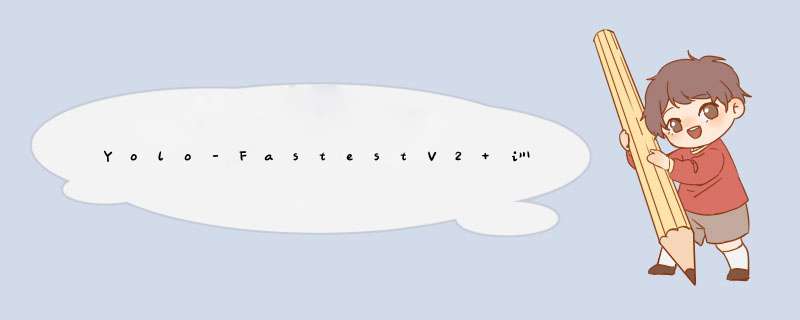
根据原作者源码及说明实践后总结
*** 作环境Ubuntu 18.02 +cuda 11.1 +pytorch 1.9.0
作者源码下载:https://github.com/dog-qiuqiu/Yolo-FastestV2
新建:
conda create -n yolov2 python=3.8
安装pytorch:
conda install pytorch torchvision torchaudio cudatoolkit=11.1 -c pytorch -c nvidia
下载源码:
git clone https://github.com/dog-qiuqiu/Yolo-FastestV2
安装依赖包:
pip install -r requirements.txt测试图片:
python test.py --data data/coco.data --weights modelzoo/coco2017-0.241078ap-model.pth --img img/000139.jpg
测试成功!没有问题,就可以开始训练自己的数据集啦!
构建数据集:此方法是将 voc 格式数据集转换为符合此算法的数据集格式
以下三个文件放在新建的data数据集里
使用maketxt.py划分测试集验证集
import os
import random
trainval_percent = 0.1
train_percent = 1
xmlfilepath = './data/Annotations'
total_xml = os.listdir(xmlfilepath)
num = len(total_xml)
list = range(num)
tv = int(num * trainval_percent)
trainval = random.sample(list, tv)
txt_train='./data/ImageSets/train.txt'
if os.path.exists(txt_train):
os.remove(txt_train)
else:
open(txt_train,'w')
txt_val='./data/ImageSets/val.txt'
if os.path.exists(txt_val):
os.remove(txt_val)
else:
open(txt_val,'w')
ftrain = open(txt_train, 'w')
fval = open(txt_val, 'w')
for i in list:
name = total_xml[i][:-4] + 'n'
ftrain.write(name)
if i in trainval:
fval.write(name)
ftrain.close()
fval.close()
划分好验证集测试集后,会在ImageSets文件中生成train.txt和val.txt
使用voc_label.py生成.txt标签文件
voc_label.py
# -*- coding: utf-8 -*-
# xml解析包
import xml.etree.ElementTree as ET
import os
from os import getcwd
import shutil
sets = ['train', 'val']
classes = ['apple','cup','house']
style = '.jpg'
#判断文件是否为空
def ifnone(path) :
if os.path.exists(path):
#print("文件存在")
if os.path.getsize(path):
#print("文件存在且不为空")
#print(os.path.getsize(FILE))
Size=os.path.getsize(path)
os.system('ls -lh %s' %(path))
return 1
else:
#print("文件存在但为空...")
os.system('ls -lh %s' %(path))
return 2
# 进行归一化 *** 作
def convert(size, box): # size:(原图w,原图h) , box:(xmin,xmax,ymin,ymax)
dw = 1. / size[0] # 1/w
dh = 1. / size[1] # 1/h
x = (box[0] + box[1]) / 2.0 # 物体在图中的中心点x坐标
y = (box[2] + box[3]) / 2.0 # 物体在图中的中心点y坐标
w = box[1] - box[0] # 物体实际像素宽度
h = box[3] - box[2] # 物体实际像素高度
x = x * dw # 物体中心点x的坐标比(相当于 x/原图w)
w = w * dw # 物体宽度的宽度比(相当于 w/原图w)
y = y * dh # 物体中心点y的坐标比(相当于 y/原图h)
h = h * dh # 物体宽度的宽度比(相当于 h/原图h)
return (x, y, w, h) # 返回 相对于原图的物体中心点的x坐标比,y坐标比,宽度比,高度比,取值范围[0-1]
# year ='2012', 对应图片的id(文件名)
def convert_annotation(image_id):
'''
将对应文件名的xml文件转化为label文件,xml文件包含了对应的bunding框以及图片长款大小等信息,
通过对其解析,然后进行归一化最终读到label文件中去,也就是说
一张图片文件对应一个xml文件,然后通过解析和归一化,能够将对应的信息保存到唯一一个label文件中去
labal文件中的格式:calss x y w h 同时,一张图片对应的类别有多个,所以对应的bunding的信息也有多个
'''
# 对应的通过year 找到相应的文件夹,并且打开相应image_id的xml文件,其对应bund文件
in_file = open('./data/Annotations/%s.xml' % (image_id), encoding='utf-8')
# 准备在对应的image_id 中写入对应的label,分别为
#
out_file = open('./data/JPEGimages/%s.txt' % (image_id), 'w', encoding='utf-8')
# 解析xml文件
tree = ET.parse(in_file)
# 获得对应的键值对
root = tree.getroot()
# 获得图片的尺寸大小
size = root.find('size')
# 如果xml内的标记为空,增加判断条件
if size != None:
# 获得宽
w = int(size.find('width').text)
# 获得高
h = int(size.find('height').text)
# 遍历目标obj
for obj in root.iter('object'):
# 获得difficult ??
difficult= 0
if obj.find('difficult')!=None :
difficult = obj.find('difficult').text
# 获得类别 =string 类型
cls = obj.find('name').text
#print("display",image_id,cls,difficult)
# 如果类别不是对应在我们预定好的class文件中,或difficult==1则跳过
if cls not in classes or int(difficult) == 1:
continue
# 通过类别名称找到id
cls_id = classes.index(cls)
# 找到bndbox 对象
xmlbox = obj.find('bndbox')
# 获取对应的bndbox的数组 = ['xmin','xmax','ymin','ymax']
b = (float(xmlbox.find('xmin').text), float(xmlbox.find('xmax').text), float(xmlbox.find('ymin').text),
float(xmlbox.find('ymax').text))
#print(image_id, cls, b)
# 带入进行归一化 *** 作
# w = 宽, h = 高, b= bndbox的数组 = ['xmin','xmax','ymin','ymax']
bb = convert((w, h), b)
# bb 对应的是归一化后的(x,y,w,h)
# 生成 calss x y w h 在label文件中
out_file.write(str(cls_id) + " " + " ".join([str(a) for a in bb]) + 'n')
# 返回当前工作目录
wd = getcwd()
#print(wd)
# 先找labels文件夹如果不存在则创建
#labels = './data/labels'
#if os.path.exists(labels):
# shutil.rmtree(labels) # delete output folder
#os.makedirs(labels) # make new output folder
for image_set in sets:
'''
对所有的文件数据集进行遍历
做了两个工作:
1.将所有图片文件都遍历一遍,并且将其所有的全路径都写在对应的txt文件中去,方便定位
2.同时对所有的图片文件进行解析和转化,将其对应的bundingbox 以及类别的信息全部解析写到label 文件中去
最后再通过直接读取文件,就能找到对应的label 信息
'''
# 读取在ImageSets/Main 中的train、test..等文件的内容
# 包含对应的文件名称
image_ids = open('./data/ImageSets/%s.txt' % (image_set)).read().strip().split()
# 打开对应的2012_train.txt 文件对其进行写入准备
txt_name = './data/%s.txt' % (image_set)
if os.path.exists(txt_name):
os.remove(txt_name)
else:
open(txt_name, 'w')
list_file = open(txt_name, 'w')
# 将对应的文件_id以及全路径写进去并换行
for image_id in image_ids:
list_file.write('./data/JPEGimages/%s%sn' % (image_id, style))
# 调用 year = 年份 image_id = 对应的文件名_id
#print(image_id)
pathxml='./data/Annotations/%s.xml' % (image_id)
xmlresult = ifnone(pathxml)#判断xml是否有空文件
if xmlresult == 1 :
convert_annotation(image_id)
elif xmlresult == 2 :
path2 = './data/JPEGImages/%s.txt' % (image_id)
file = open(path2,'w')
# 关闭文件
print("end")
list_file.close()
计算锚点偏差
python3 genanchors.py --traintxt data/train.txt
计算以后会生成anchor6.txt,把第一行复制到data的coco.data里anchors里
coco.data和coco.names解析见其他文章
训练自己的数据集python train.py --data data/coco.data测试
python test.py --data data/coco.data --weights modelzoo/coco-140-epoch-0.872988ap-model.pth --img img/000005.jpg测试多张图片用如下代码
import os
import cv2
import time
import argparse
import torch.nn as nn
import torch
import model.detector
import utils.utils
from thop import profile
if __name__ == '__main__':
# 指定训练配置文件
parser = argparse.ArgumentParser()
parser.add_argument('--data', type=str, default='',
help='Specify training profile *.data')
parser.add_argument('--weights', type=str, default='',
help='The path of the .pth model to be transformed')
parser.add_argument('--img', type=str, default='',
help='The path of test image')
opt = parser.parse_args()
cfg = utils.utils.load_datafile(opt.data)
# assert os.path.exists(opt.weights), "请指定正确的模型路径"
# assert os.path.exists(opt.img), "请指定正确的测试图像路径"
assert os.path.exists(opt.weights), "./weights/best-model.pth"
assert os.path.exists(opt.img), "./data/voc/JPEGImages/000009.jpg"
#指定后端设备
device = torch.device("cuda" if torch.cuda.is_available() else "cpu")
#初始化模型
model = model.detector.Detector(cfg["classes"], cfg["anchor_num"], True).to(device)
model = nn.DataParallel(model) # 在加载时需要把网络也转成DataParallel的
model.to(device)
model.load_state_dict(torch.load(opt.weights, map_location=device))
# sets the module in eval node
model.eval()
# 数据预处理
for jpg in os.listdir(opt.img):
ori_img = os.path.join(opt.img, jpg)
print(ori_img)
ori_img = cv2.imread(ori_img)
res_img = cv2.resize(ori_img, (cfg["width"], cfg["height"]), interpolation=cv2.INTER_LINEAR)
img = res_img.reshape(1, cfg["height"], cfg["width"], 3)
img = torch.from_numpy(img.transpose(0, 3, 1, 2))
img = img.to(device).float() / 255.0
# 模型推理
computertime = 0
start = time.perf_counter()
preds = model(img)
end = time.perf_counter()
computertime = (end - start) * 1000.
print("forward time:%fms" % computertime)
# 特征图后处理
output = utils.utils.handel_preds(preds, cfg, device)
output_boxes = utils.utils.non_max_suppression(output, conf_thres=0.5, iou_thres=0.4)
# 加载label names
LABEL_NAMES = []
with open(cfg["names"], 'r') as f:
for line in f.readlines():
LABEL_NAMES.append(line.strip())
h, w, _ = ori_img.shape
scale_h, scale_w = h / cfg["height"], w / cfg["width"]
# 绘制预测框
for box in output_boxes[0]:
box = box.tolist()
obj_score = box[4]
category = LABEL_NAMES[int(box[5])]
x1, y1 = int(box[0] * scale_w), int(box[1] * scale_h)
x2, y2 = int(box[2] * scale_w), int(box[3] * scale_h)
cv2.rectangle(ori_img, (x1, y1), (x2, y2), (255, 255, 0), 2)
cv2.putText(ori_img, '%.2f' % obj_score, (x1, y1 - 5), 0, 0.7, (0, 255, 0), 2)
cv2.putText(ori_img, category, (x1, y1 - 25), 0, 0.7, (0, 255, 0), 2)
cv2.imwrite("datatest/testresult/{}.jpg".format(jpg.split(".")[0]), ori_img)
评估数据集
python3 evaluation.py --data data/coco.data --weights weights/best-model.pth
欢迎分享,转载请注明来源:内存溢出

 微信扫一扫
微信扫一扫
 支付宝扫一扫
支付宝扫一扫
评论列表(0条)